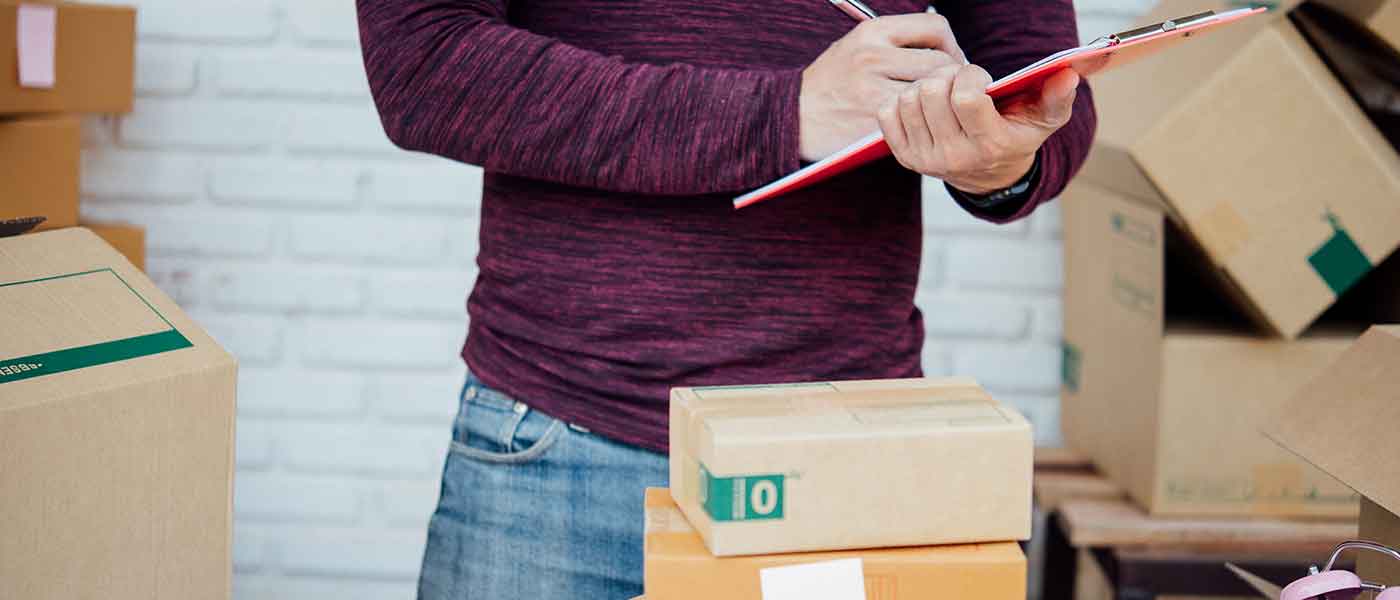What is an Order Shipping Label?
Shipping labels are tags fixed on delivery packages like parcels, cans, boxes, etc., and are used for identification. The shipping labels give a brief description of the contents of the package. Additionally, it also contains valuable information for delivery like address, name of the consigner, name of the consignee, weight, barcodes for tracking, etc.
Although shipping labels might look like a tiny part of the e-commerce domino, they form an integral portion of both inbound and outbound logistics. They contribute to the e-commerce website’s success, reach, impact, and client satisfaction.
The brilliance behind these shipping labels is their ability to monitor, control, and track the orders placed while contributing to a seamless customer experience. These also help increase customer service satisfaction and brand loyalty, resulting in maximum profits.
The conventional method of using manual instructions to pass on delivery instructions has vanished with the emergence of these new shipping labels. With modern automated technological solutions, shipping labels today enable you to access all package information at any time in the supply chain management process.
Most organizations create their own shipping labels to save time and money. This is done to take advantage of the offered postage discounts and enable easy pickup arrangements from any local carrier.
The added advantage of these labels is that all the information retrieved upon scanning the barcodes is proprietary and is limited to the company in charge of package delivery and the customer. It uses proprietary warehouse management software to guarantee security and privacy while providing live metrics. These metrics are then used for data analytics and other functions.
What Information Do Order Shipping Labels Contain?
As already mentioned, shipping labels contain valuable identification data that helps you keep track of your delivery packages. Although most shipping labels are customized, they more or less carry similar information. Most shipping labels carry eight important elements. These include:
- Consignee’s name and address: This section of the shipping label contains all the essential information regarding the recipient. It tells us where the package will be delivered and to whom it should be delivered.
- Consignor’s name and address: This section of the shipment label contains the sender’s name and address. It is a vital piece of information that must be stated on the label in case the consignee is unable to collect the delivery or in case of returning the package.
- Package weight: It is the gross weight of the item being shipped and the packaging material. Information regarding the weight of the package is essential as it determines how the package will be delivered.
- Maxicode: It is also known as the unidirectional code. It could be an Aztec or QR code that allows you to track and manage the package’s shipment process. This code makes use of dots instead of bars.
- Postal barcode: The receiver’s postal code or zip code is generally barcoded on the shipping label to allow easy delivery, tracking, and finding the location.
- Tracking number: As the name suggests, it is a unique number specific to the package that helps you determine the exact details at any time.
- Delivery service type: It is an indication of the speed of delivery. It helps one identify whether the package is express, priority, standard, or fragile. It enables you to meet customer demand and build better delivery experiences while meeting deadlines.
- Routing number: The routing number is another identification and tracking element that helps you identify where the package has to be sent and the path it must follow.
What is a Return Shipping Label?
A return shipping label is another sticker affixed on the package that includes a shipping barcode and the sender’s address. The shipping barcode contains all relevant details about the parcel, including the delivery date and delivery path.
It entails the entire shipment process and can be retrieved by simply scanning the code. The return labels are used to help in transferring the package back to the appropriate warehouse.
Here are a few reasons why return labels are used on packages:
- Saves the recipients time and effort
The inclusion of the return label makes it easier for the receiver. The need to request a return label is eliminated. It ensures seamless delivery and returns policies for your customers that, in turn, help you build your brand.
- Zero cost of the label unless used
The only loss of using return labels on your packages is paper wastage. Return labels otherwise have no cost implication unless the customer uses them. It serves as an effective and affordable tool to ensure seamless delivery and return services. It increases the odds of you multiplying your returns and improving customer satisfaction.
- Ensures safe return of packages
The return labels help you get the packages back without any problem. They allow you to track them in all instances, making it less likely to acquire a loss after the return. It acts as a safety net during return services.
- Seamless return policy
A return policy helps you reach a larger crowd as the chance of your audience buying something from you increases. It helps them build a sense of security with your brand and gives them the flexibility to love or hate your products and services.
How to Create Shipping Labels Online?
The creation of shipping labels is not a hard task. These can be created in different ways, and the method can be chosen based on convenience and affordability. The great part of shipping labels is that you can make them using a combination of manual and automated techniques.
Here are the three most common ways of making shipping labels:
- Manual generation or self-fulfillment
Self-fulfillment labels are generally used by those who use local delivery partners to complete their delivery. A sign-up and probably a convenience fee will be charged to access these labels to complete the process. The manual labels require you to download the template of the local delivery agency and manually fill out the necessary details as per the guidelines.
You will be responsible for the entire process of downloading, filling out the essential details, printing the label, and affixing it to the package. The manual method is most suitable for organizations that do not ship orders on a large scale. It is necessary to be precise and very careful to avoid any errors in this process.
- Software solutions for generation
Label making is not rocket science. It is a simple task that can be done easily using the software. With today’s immense technological advancement, this process is relatively simple, and many software to create labels are available. These allow you to generate, design and format the labels as per your requirements.
You also have the versatility to add and remove information on the label to suit your convenience. The labels can be generated at very affordable prices using software solutions.
- 3PL shipping solutions
Many different shipping solution platforms also provide all-round solutions. They provide pre-paid shipping labels that allow you to print these solutions directly from their panel. It is beneficial and resourceful as it saves you a lot of time and effort you would otherwise have allocated for manually generated labels.
These solutions come with pre-filled data that can be customized to meet the requirements of your organization. Hence it helps you avoid logistical problems affecting your overall customer experience.
Simple Ways to Create a Shipping Label from the Phone
The mobile-first era has made the process of label generation rather easy and mobile. You no longer have to sit in front of a computer to get things done. You can easily do all of this on your phone or tablet. Your orders are linked onto a secure platform allowing you to view them on your phone through a specialized application. You can generate labels in a few simple steps for all your orders. The steps include:
- Step 1: Log on to the application.
- Step 2: Tap on your order list and click the order that requires label generation.
- Step 3: You can then choose your local carrier and desired shipping service.
- Step 4: You can then buy and modify the shipping label you wish to choose.
- Step 5: Print the chosen label.
It is quite a simple method to use to deliver excellent customer service. You no longer need the rigidity of a laptop. You can do it with ease on your phone. Moreover, it is hassle-free and allows you to control all your orders on the go. The application deployed to control and track your orders can be modified and designed to suit your needs.
Another brilliant advantage of using your phone or tablet is its portability. You can use it on any operating system, allowing you the flexibility of having it your way. Third-party applications also offer you a wide range of solutions to meet all your labeling needs at very reasonable prices. Here are a few advantages of using label-making applications on your phone:
- You can determine when and how your labels are generated.
- You only pay when you buy a label.
- This software can be integrated easily with any existing system.
- Enables remote access and control
- Helps you manage and monitor your orders anytime, anywhere
How to Use Manual Shipping Labels?
Manual shipping labels are used by those who do not ship large-scale orders. These are self-filled labels and require precision from the person in charge of filling them. These labels work out when there isn’t too much confusion with multiple orders.
Steps to use manual shipping labels:
- Step 1: Sign in to the delivery agent of your choice.
- Step 2: Download the standard delivery label template provided by the shipping company.
- Step 3: Carefully read all the guidelines mentioned before filling out the label.
- Step 4: Precisely fill out the label with the necessary details per the guidelines.
- Step 5: Print and use the label where necessary.
Shipping Forms and Labels
As mentioned earlier, shipping labels and forms are all identification documents used to understand the entire lifecycle of the parcel from the time of packing in the warehouse until delivery to the customer. The shipping form is a document that contains all the information and in-detail references about what the parcel or package contains. It also has information about the price, precise dimensions, nature of the item packed, type of item packed, etc. It includes all relevant data that meets the national standards of shipping.
In simple terms, a shipping form is a detailed document with all the relevant details regarding the parcel and the items packed within. In contrast, a shipping label is a tracking element and a guide to help get the parcel to the customer seamlessly. These documents are essential for discrepancies and audits for verification and traceability purposes.
The shipping form might also contain information regarding certain document numbers of documents like certificates of origin, e-way bills, insurance details, packing lists, instruction manuals, etc.
Order Shipping Label: Best Practices
Verifying any important detail that is missing while making a shipping label is crucial. Missing information could make or break your delivery service and overall customer experience. Here are a few things that you need to keep in mind while making your shipping label:
- Ensure you make room for special instructions
The ultimate goal is to ensure that your customers enjoy your services at their best. Ensuring that you make this arrangement on your label can help you give them the best experience. This provision allows you to add instructions on parcel handling. The item could be perishable or fragile; this box will enable you to describe it.
- Label placement
The placement could affect visibility and legibility. It is vital to ensure that the label is placed in the right spot where there are no blocks. Placing it properly without any folds, creases, and bumps gives you a seamless transaction as these are scanned to track. Using plastic or transparent tape to protect your label is a good practice to ensure that it is not damaged.
- Packing slips
The packing slip is also known as the waybill. It includes item descriptions and details along with a receipt. It must include necessary information, including the order number, addresses, handling details, invoices, etc.
- Ensuring labels are printer-friendly
The labels must be formattable and scalable. Labels should be such that they can be printed effortlessly. The labels form a crucial part of the delivery system and hence must be readable and scannable to keep track of the parcel. It is the key step in ensuring a seamless delivery experience with an on-time arrival.
FAQs
Does every package need a shipping label?
Without clear shipping labels, packages might get lost or delayed in transit, creating trouble and affecting your overall customer experience. Hence, it is advised that all packages must have shipping labels.
What size should a shipping label be?
A shipping label can be made as per convenience and requirement. However, 4×6 inch and 6×3 inch labels are most commonly used.
Does the shipping label size matter?
The size matters as it has to contain all the necessary information without compromising legibility.
Can shipping labels be printed on paper?
Yes, shipping labels can be printed on paper.
Do shipping labels require a special printer?
No, shipping labels can be printed on any printer and any type of paper with the combination of a self-adhesive.









